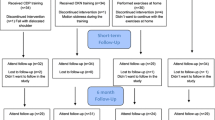Abstract
Using a diagnostic prospective cohort single center study design, the influence of a cervical collar on standing balance during dynamic postural perturbations in healthy adults and patients with acute unilateral vestibular dysfunction was measured in 31 healthy subjects and 27 patients with acute unilateral vestibular loss. The main outcome measures were completed standard protocols on the Sensory Organization Test (SOT) and Motor Control Test (MCT) of the NeuroCom Equitest® computerized posturography platform measured without and with acute cervical fixation, respectively. Paired t test showed no significant difference during the six conditions of neither the SOT scores nor analyzing the SOT strategies or during the MCT between the non-fixed and fixed neck in healthy subjects and in the patients (all p > 0.05). Older healthy subjects showed decreased SOT scores but equal MCT results. The age effect was more dominant in the patients when wearing the collar. Gender had no influence whether in healthy individuals nor in patients. In almost all conditions of the SOT but only in some MCT subtests patients had significantly lower scores than healthy subjects without collar and with collar (all p < 0.05). In conclusion, the SOT but only some subtest of the MCT could clearly distinguish between healthy adults and patient with acute unilateral vestibular loss. Equilibrium scores did not change significantly when the cervical spine was fixed with a collar. Acute fixation of the neck with a collar seems not to affect standing balance, even not when vestibular, visual and/or somatosensory input are also reduced.

Similar content being viewed by others
References
Burl MM, Williams JG, Nayak US (1992) Effects of cervical collars on standing balance. Arch Phys Med Rehabil 73:1181–1185
Cooper S, Daniel PM (1963) Muscle spindles in man; their morphology in the lumbricals and the deep muscles of the neck. Brain 86:563–586
Abrahams VC (1977) The physiology of neck muscles; their role in head movement and maintenance of posture. Can J Physiol Pharmacol 55:332–338
Treleaven J (2008) Sensorimotor disturbances in neck disorders affecting postural stability, head and eye movement control. Manual Ther 13:2–11
Ivanenko YP, Grasso R, Lacquaniti F (2000) Neck muscle vibration makes walking humans accelerate in the direction of gaze. J Physiol 525:803–814
Bove M, Diverio M, Pozzo T et al (2001) Neck muscle vibration disrupts steering of locomotion. J Appl Physiol 91:581–588
Armstrong B, McNair P, Taylor D (2008) Head and neck position sense. Sports Med 38:101–117
Treleaven J, LowChoy N, Darnell R et al (2008) Comparison of sensorimotor disturbance between subjects with persistent whiplash-associated disorder and subjects with vestibular pathology associated with acoustic neuroma. Arch Phys Med Rehabil 89:522–530
Jongkees LB (1968) Electronystagmography: its use and usefulness. Ann Otol Rhinol Laryngol 77:733–739
Schikora N, Eysel-Gosepath K, Klunter H et al (2010) Influence of cervical spine stabilization via stiff neck on the postural system in healthy patients: compensation or decompensation of the postural system? Eur Arch Otorhinolaryngol 267:1623–1628
Allum JH, Adkin AL, Carpenter MG et al (2001) Trunk sway measures of postural stability during clinical balance tests: effects of a unilateral vestibular deficit. Gait Posture 14:227–237
Di Fabio RP (1995) Sensitivity and specificity of platform posturography for identifying patients with vestibular dysfunction. Phys Therapy 75:290–305
Clarke AH (2010) Laboratory testing of the vestibular system. Curr Opin Otolaryngol Head Neck Surg 18:425–430
Calo L, Rabini A, Picciotti PM et al (2009) Postural control in patients with total hip replacement. Eur J Phys Rehabil Med 45:327–334
Mathias M, Rougier PR (2010) In healthy subjects, the sitting position can be used to validate the postural effects induced by wearing a lumbar lordosis brace. Ann Phys Rehabil Med 53:511–519
Munoz F, Salmochi JF, Faouen P et al (2010) Low back pain sufferers: is standing postural balance facilitated by a lordotic lumbar brace? Orthop Traumatol Surg Res 96:362–366
Gill J, Allum JH, Carpenter MG et al (2001) Trunk sway measures of postural stability during clinical balance tests: effects of age. J Gerontol 56:M438–M447
Conflict of interest
The authors indicate that they have no financial relationship with any organization or company mentioned in the manuscript. The research was not sponsored by a third party.
Author information
Authors and Affiliations
Corresponding author
Rights and permissions
About this article
Cite this article
Bohne, S., Heine, S., Volk, G.F. et al. Postural responses without versus with acute external cervical spine fixation: a comparative study in healthy subjects and patients with acute unilateral vestibular loss. Eur Arch Otorhinolaryngol 270, 61–67 (2013). https://doi.org/10.1007/s00405-011-1911-5
Received:
Accepted:
Published:
Issue Date:
DOI: https://doi.org/10.1007/s00405-011-1911-5




